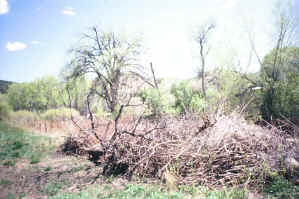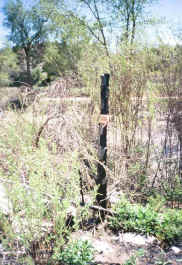
Table of Contents:
Blue orchard bees were found
in large numbers!
Trapnests had little activity
Why are they abundant in northern New Mexico?
Other insect visitors to fruit trees
Seed set in participating apple orchards
Recommendations and Future Plans
Blue orchard bees, Osmia lignaria, were found in large numbers everywhere in the Rio Arriba area of Northern New Mexico from Peña Blanca toTaos (see Participants for information about the orchards included in the study). These bees were collected on peach, plum, apple and cherry. They may also visit apricot in small numbers, but I did not have time to look. In many of the orchards that I visited, O. lignaria may have been the primary pollinator of fruit trees.
The highest abundance of Osmia was seen in orchards that abut the Rio Grande in Rinconada and the Embudo River in Dixon. In these areas there was abundant plum and peach bloom early in the season, and apple later in the season. There was plenty of brush, dead wood, and fence posts for nest building. Mud for nest partitions was also readily available. The Peña Blanca area also had large populations of blue orchard bees. Orchard owners in these areas should make a special effort to maintain forage and nesting habitat to assure that bee populations continue.
| Rinconada is one community along
the Rio Grande in Northern New Mexico that is blessed with excellent
habitat for native bees, as well as climate and water resources conducive
to fruit growing.
Anna Sopyn's orchard. |
I did not see blue orchard bees in Belen or Bosque Farms. Both of those orchards were visited extensively by honeybees. The orchards are in more open habitat than the orchards of the Rio Arriba area. The bosque habitat has less brush available for Osmia nesting.
Apple did not bloom at higher elevation sites until after I had to leave New Mexico at the beginning of May. Therefore, I am not certain how abundant blue orchard bees are at high elevations. One Osmia male was collected searching for emerging females around a fence post near blooming plum trees in Valdez on April 27. Another male was collected on wild plum in Taos Canyon at 8000 ft. Sites above 7500 ft probably had fewer O. lignaria than did elevations between 6000 and 7000 ft. The species is supposed to be absent above 8,000 ft.
Trapnests had little activity
Most of the trap nests that were placed in orchards were not used by O. lignaria during bloom. Exceptions were the orchards where the bees were released in Alcalde and Velarde. Many of the trap nests were attached to branches of blooming fruit trees; these were ignored by the Osmia. Trap nests that were occupied had been placed on fence posts or other dead wood at the edge of the orchard, rather than in the live fruit trees. O. lignaria prefers to nest close to the place that it emerges, and bees were unlikely to emerge from live trees. The success of trap nests could be improved by not placing them in live trees, and/or by including a few occupied nests or a few cocoons in each bundle of trap nests.
 Good habitat for placing trapnests for twig-nesting bees and wasps including Osmia. Dixon, NM: Photo by K. Strickler |
Burnt logs
often attract Osmia; they nested in several of the trapnests on
this fence post in Dixon, N.M. Click on photo to see an enlargement. Photo by K. Strickler |
 |
Summer bees and solitary wasps that are useful for biological control of insect pests also used the trap nests after fruit bloom. A number of species were common, including:
| Leafcutting bees, Megachile sp. which line their cells with pieces of leaf | |
| The wasp genus Isodontia, which is a predator of crickets, katydids, grasshoppers and the like. Cells are lined with plant fibers such as grass stems and blades. Often these fibers are packed into a plug with fibers sticking out of the nest entrance. | |
| Solitary wasps that fill the cells with small caterpillars or beettle larvae and make mud partitions. |
Why is O. lignaria abundant in N. New Mexico?
My impression is that O. lignaria were originally found in the Rio Grande valley foraging from wild plum, Prunus americana, a riparian plant important in the diet of the Pueblo Indians. When the Spanish colonists introduced fruit trees, the bee populations must have added them to their foraging repertoire. Nest sites are apparently readily available along the rivers where there is lots of brush and dead trees. Pesticides are not used during bloom. Small acreage means a high ratio of refuge habitat to orchard area. Many orchards are managed organically, or are no longer managed commercially and thus are excellent habitat for these bees. Most of the small orchards visited did not bring in honey bee hives for pollination.
Other insect visitors to fruit trees
All orchards were visited by a number of species of syrphid or hover flies, many of which look like bees. These flies hover in front of flowers, and tend to stay around the same part of the tree. They do not move much between trees. They probably contribute only a little to pollination.
Moths were another common visitor of fruit trees. Some of these may be excellent pollinators, particularly the hummingbird-like sphinyx moths that visit flowers late in the day. A few wasps also foraged on flowers. Notable are the long, thin yellow and black tiphiid wasps which make lots of noise as they seem to crash around the branches. I collected tiphiids in Peña Blanca and saw them in several orchards. They may be moderately good pollinators. Their larvae are parasites of beetles such as May beetles, and thus are considered beneficial.
In addition to Osmia lignaria, one Osmia ribifloris individual was collected foraging on apple in the Peña Blanca area. Two species of Andrena, ground nesting "mining bees" were collected in a number of orchards. They are relatively large for the genus, about the size of O. lignaria but less robust, more elongate. One is wasp-like, with rust, black and a bit of yellow stripes on it's abdomen. It's wings are smoky brown in color rather than clear like most bees. Another Andrena species appears to be a mimic of Osmia. It is about the same size as O. lignaria and the same blue-black color. However, it collects pollen on it's hind legs rather than under it's abdomen. Two or three other small species of Andrena were collected from a few orchards, as well as an occasional ground-nesting sweat bee and yellow-faced bee. Bumblebees were common in the orchards. Tentatively they are identified as Bombus nevadensis and B. huntii (see the Bumble bees of Northern Utah on the USDA Bee Lab web site). Bumble bees are excellent fruit pollinators. Honey bees were also common visitors, even in orchards where no hives were present, though usually their numbers were small.
Seed set in participating apple orchards
I returned to New Mexico in early Sept. to retrieve the trap nests. In some of the apple orchards I also sampled fruit to determine the average number of seeds per apple, a measure of successful pollination. Yield is not a good measure of pollination in many cases, because most trees must be thinned. If too many flowers are allowed to set fruit, the fruit will be small and poor quality. Also, weather and last year's yield affect amount of bloom.
The seed samples were very preliminary, but they suggest that those orchards that were pollinated by native bees had as high a seed set as orchards pollinated by honeybees. One orchard that was pollinated by both native bees and honeybees seemed to have the highest seed set per fruit. A recent study of hybrid sunflowers showed that more pollen was transfered from male fertile to male sterile flowers when both honeybees and native bees foraged from the flowers than when only honeybees foraged. The honeybees apparently picked up pollen left behind by native bees. Perhaps the same synergism occurs in apple flowers.
Recommendations and Future Plans
In the main fruit growing regions of northern New Mexico wild bees were plentiful in 2001. They probably did a good job of pollination. Sampling for a few more years will tell us if this situation is stable. In many orchards growers need only be aware of the presence of these bees, and maintain their habitat to insure good pollination. Pollinator Paradise, in collaboration with NMSU researchers and county extension agents, has submitted a Sustainable Agriculture Research and Education (SARE) grant to the USDA to continue and expand the research on pollination in New Mexico orchards, and to establish an education program to make orchard owners aware of the presence of these bees.
Orchards farther from the main Osmia populations along the rivers might benefit from providing increased nesting sites and perhaps a more reliable source of mud than is currently available to increase their the bee populations. Pollinator Paradise will work with participating growers who wish to increase their Osmia populations. Contact us for more information.
Trap nests collected in 2001 will be opened in March before bloom. Some specimens will be retained for identification, and the rest of the beneficial bees and wasps will be returned to .the orchard where they were collected, or nearby. New nesting materials that we hope will be attractive to blue orchard bees will be field tested.
If our SARE grant is funded, we plan to survey several additional fruit-growing areas of New Mexico to see if Osmia are present there. This will include orchards in the Mora area east of the Sangre de Cristo and Santa Fe Mts., in the fruit - growing region of the Sacramento Mts. of southern New Mexico, and possibly in the Farmington area. If you live in New Mexico and are interested in participating, if you have a few fruit trees up to several acres, fill out the participation form.
In areas of New Mexico where Osmia are abundant, consider putting trapnests around the periphery of your orchard to increase Osmia populations. Pollinator Paradise will seek markets for these bees if they are relatively free of parasites and predators. We will work with growers to sell the bees as an additional source of income. Furthermore, if the public is educated about the importance of the blue orchard bee, the bees could become a marketing tool for New Mexican Fruit. Pollinator Paradise will work to educate the public about the value of Osmia and other wild bee pollinators.
Top of page